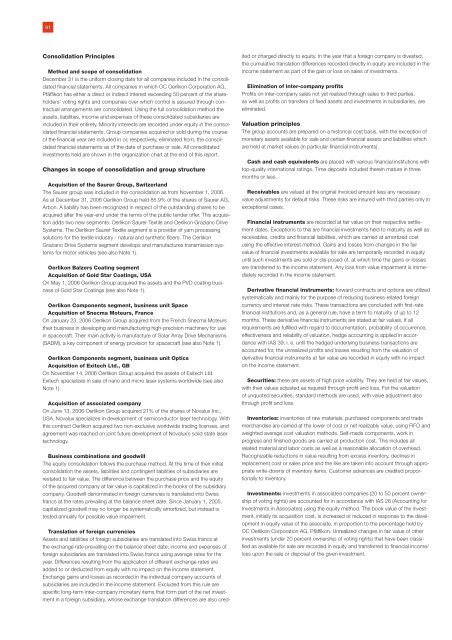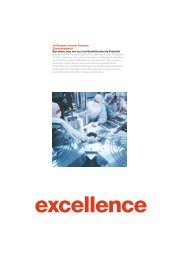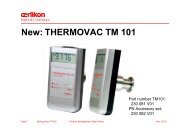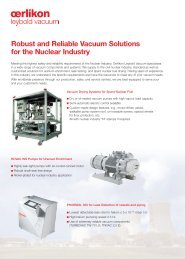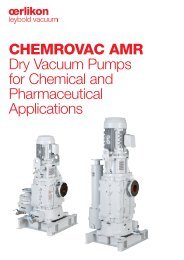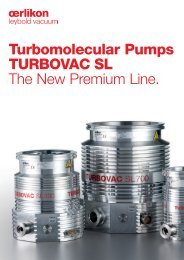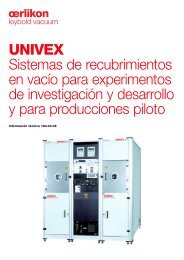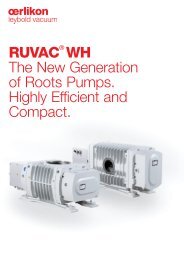Consolidation Principles Changes in scope of consolidation and ...
Consolidation Principles Changes in scope of consolidation and ...
Consolidation Principles Changes in scope of consolidation and ...
Create successful ePaper yourself
Turn your PDF publications into a flip-book with our unique Google optimized e-Paper software.
91<br />
<strong>Consolidation</strong> <strong>Pr<strong>in</strong>ciples</strong><br />
Method <strong>and</strong> <strong>scope</strong> <strong>of</strong> <strong>consolidation</strong><br />
December 31 is the uniform clos<strong>in</strong>g date for all companies <strong>in</strong>cluded <strong>in</strong> the consolidated<br />
f<strong>in</strong>ancial statements. All companies <strong>in</strong> which OC Oerlikon Corporation AG,<br />
Pfäffikon has either a direct or <strong>in</strong>direct <strong>in</strong>terest exceed<strong>in</strong>g 50 percent <strong>of</strong> the shareholders’<br />
vot<strong>in</strong>g rights <strong>and</strong> companies over which control is assured through contractual<br />
arrangements are consolidated. Us<strong>in</strong>g the full <strong>consolidation</strong> method the<br />
assets, liabilities, <strong>in</strong>come <strong>and</strong> expenses <strong>of</strong> these consolidated subsidiaries are<br />
<strong>in</strong>cluded <strong>in</strong> their entirety. M<strong>in</strong>ority <strong>in</strong>terests are recorded under equity <strong>in</strong> the consolidated<br />
f<strong>in</strong>ancial statements. Group companies acquired or sold dur<strong>in</strong>g the course<br />
<strong>of</strong> the f<strong>in</strong>ancial year are <strong>in</strong>cluded <strong>in</strong> or, respectively, elim<strong>in</strong>ated from, the consolidated<br />
f<strong>in</strong>ancial statements as <strong>of</strong> the date <strong>of</strong> purchase or sale. All consolidated<br />
<strong>in</strong>vestments held are shown <strong>in</strong> the organization chart at the end <strong>of</strong> this report.<br />
<strong>Changes</strong> <strong>in</strong> <strong>scope</strong> <strong>of</strong> <strong>consolidation</strong> <strong>and</strong> group structure<br />
Acquisition <strong>of</strong> the Saurer Group, Switzerl<strong>and</strong><br />
The Saurer group was <strong>in</strong>cluded <strong>in</strong> the <strong>consolidation</strong> as from November 1, 2006.<br />
As at December 31, 2006 Oerlikon Group held 85.9% <strong>of</strong> the shares <strong>of</strong> Saurer AG,<br />
Arbon. A liability has been recognized <strong>in</strong> respect <strong>of</strong> the outst<strong>and</strong><strong>in</strong>g shares to be<br />
acquired after the year-end under the terms <strong>of</strong> the public tender <strong>of</strong>fer. This acquisition<br />
adds two new segments: Oerlikon Saurer Textile <strong>and</strong> Oerlikon Graziano Drive<br />
Systems. The Oerlikon Saurer Textile segment is a provider <strong>of</strong> yarn process<strong>in</strong>g<br />
solutions for the textile <strong>in</strong>dustry - natural <strong>and</strong> synthetic fibers. The Oerlikon<br />
Graziano Drive Systems segment develops <strong>and</strong> manufactures transmission systems<br />
for motor vehicles (see also Note 1).<br />
Oerlikon Balzers Coat<strong>in</strong>g segment<br />
Acquisition <strong>of</strong> Gold Star Coat<strong>in</strong>gs, USA<br />
On May 1, 2006 Oerlikon Group acquired the assets <strong>and</strong> the PVD coat<strong>in</strong>g bus<strong>in</strong>ess<br />
<strong>of</strong> Gold Star Coat<strong>in</strong>gs (see also Note 1).<br />
Oerlikon Components segment, bus<strong>in</strong>ess unit Space<br />
Acquisition <strong>of</strong> Snecma Moteurs, France<br />
On January 23, 2006 Oerlikon Group acquired from the French Snecma Moteurs<br />
their bus<strong>in</strong>ess <strong>in</strong> develop<strong>in</strong>g <strong>and</strong> manufactur<strong>in</strong>g high-precision mach<strong>in</strong>ery for use<br />
<strong>in</strong> spacecraft. Their ma<strong>in</strong> activity is manufacture <strong>of</strong> Solar Array Drive Mechanisms<br />
(SADM), a key component <strong>of</strong> energy provision for spacecraft (see also Note 1).<br />
Oerlikon Components segment, bus<strong>in</strong>ess unit Optics<br />
Acquisition <strong>of</strong> Exitech Ltd., GB<br />
On November 14, 2006 Oerlikon Group acquired the assets <strong>of</strong> Exitech Ltd.<br />
Exitech specializes <strong>in</strong> sale <strong>of</strong> nano <strong>and</strong> micro laser systems worldwide (see also<br />
Note 1).<br />
Acquisition <strong>of</strong> associated company<br />
On June 13, 2006 Oerlikon Group acquired 21% <strong>of</strong> the shares <strong>of</strong> Novalux Inc.,<br />
USA. Novalux specializes <strong>in</strong> development <strong>of</strong> semiconductor laser technology. With<br />
this contract Oerlikon acquired two non-exclusive worldwide trad<strong>in</strong>g licenses, <strong>and</strong><br />
agreement was reached on jo<strong>in</strong>t future development <strong>of</strong> Novalux’s solid state laser<br />
technology.<br />
Bus<strong>in</strong>ess comb<strong>in</strong>ations <strong>and</strong> goodwill<br />
The equity <strong>consolidation</strong> follows the purchase method. At the time <strong>of</strong> their <strong>in</strong>itial<br />
<strong>consolidation</strong> the assets, liabilities <strong>and</strong> cont<strong>in</strong>gent liabilities <strong>of</strong> subsidiaries are<br />
restated to fair value. The difference between the purchase price <strong>and</strong> the equity<br />
<strong>of</strong> the acquired company at fair value is capitalized <strong>in</strong> the books <strong>of</strong> the subsidiary<br />
company. Goodwill denom<strong>in</strong>ated <strong>in</strong> foreign currencies is translated <strong>in</strong>to Swiss<br />
francs at the rates prevail<strong>in</strong>g at the balance sheet date. S<strong>in</strong>ce January 1, 2005,<br />
capitalized goodwill may no longer be systematically amortized, but <strong>in</strong>stead is<br />
tested annually for possible value impairment.<br />
Translation <strong>of</strong> foreign currencies<br />
Assets <strong>and</strong> liabilities <strong>of</strong> foreign subsidiaries are translated <strong>in</strong>to Swiss francs at<br />
the exchange rate prevail<strong>in</strong>g on the balance sheet date; <strong>in</strong>come <strong>and</strong> expenses <strong>of</strong><br />
foreign subsidiaries are translated <strong>in</strong>to Swiss francs us<strong>in</strong>g average rates for the<br />
year. Differences result<strong>in</strong>g from the application <strong>of</strong> different exchange rates are<br />
added to or deducted from equity with no impact on the <strong>in</strong>come statement.<br />
Exchange ga<strong>in</strong>s <strong>and</strong> losses as recorded <strong>in</strong> the <strong>in</strong>dividual company accounts <strong>of</strong><br />
subsidiaries are <strong>in</strong>cluded <strong>in</strong> the <strong>in</strong>come statement. Excluded from this rule are<br />
specific long-term <strong>in</strong>ter-company monetary items that form part <strong>of</strong> the net <strong>in</strong>vestment<br />
<strong>in</strong> a foreign subsidiary, whose exchange translation differences are also cred-<br />
ited or charged directly to equity. In the year that a foreign company is divested,<br />
the cumulative translation differences recorded directly <strong>in</strong> equity are <strong>in</strong>cluded <strong>in</strong> the<br />
<strong>in</strong>come statement as part <strong>of</strong> the ga<strong>in</strong> or loss on sales <strong>of</strong> <strong>in</strong>vestments.<br />
Elim<strong>in</strong>ation <strong>of</strong> <strong>in</strong>ter-company pr<strong>of</strong>its<br />
Pr<strong>of</strong>its on <strong>in</strong>ter-company sales not yet realized through sales to third parties,<br />
as well as pr<strong>of</strong>its on transfers <strong>of</strong> fixed assets <strong>and</strong> <strong>in</strong>vestments <strong>in</strong> subsidiaries, are<br />
elim<strong>in</strong>ated.<br />
Valuation pr<strong>in</strong>ciples<br />
The group accounts are prepared on a historical cost basis, with the exception <strong>of</strong><br />
monetary assets available for sale <strong>and</strong> certa<strong>in</strong> f<strong>in</strong>ancial assets <strong>and</strong> liabilities which<br />
are held at market values (<strong>in</strong> particular f<strong>in</strong>ancial <strong>in</strong>struments).<br />
Cash <strong>and</strong> cash equivalents are placed with various f<strong>in</strong>ancial <strong>in</strong>stitutions with<br />
top-quality <strong>in</strong>ternational rat<strong>in</strong>gs. Time deposits <strong>in</strong>cluded there<strong>in</strong> mature <strong>in</strong> three<br />
months or less.<br />
Receivables are valued at the orig<strong>in</strong>al <strong>in</strong>voiced amount less any necessary<br />
value adjustments for default risks. These risks are <strong>in</strong>sured with third parties only <strong>in</strong><br />
exceptional cases.<br />
F<strong>in</strong>ancial <strong>in</strong>struments are recorded at fair value on their respective settlement<br />
dates. Exceptions to this are f<strong>in</strong>ancial <strong>in</strong>vestments held to maturity as well as<br />
receivables, credits <strong>and</strong> f<strong>in</strong>ancial liabilities, which are carried at amortized cost<br />
us<strong>in</strong>g the effective <strong>in</strong>terest method. Ga<strong>in</strong>s <strong>and</strong> losses from changes <strong>in</strong> the fair<br />
value <strong>of</strong> f<strong>in</strong>ancial <strong>in</strong>vestments available for sale are temporarily recorded <strong>in</strong> equity<br />
until such <strong>in</strong>vestments are sold or dis-posed <strong>of</strong>, at which time the ga<strong>in</strong>s or losses<br />
are transferred to the <strong>in</strong>come statement. Any loss from value impairment is immediately<br />
recorded <strong>in</strong> the <strong>in</strong>come statement.<br />
Derivative f<strong>in</strong>ancial <strong>in</strong>struments: forward contracts <strong>and</strong> options are utilized<br />
systematically <strong>and</strong> ma<strong>in</strong>ly for the purpose <strong>of</strong> reduc<strong>in</strong>g bus<strong>in</strong>ess-related foreign<br />
currency <strong>and</strong> <strong>in</strong>terest rate risks. These transactions are concluded with first-rate<br />
f<strong>in</strong>ancial <strong>in</strong>stitutions <strong>and</strong>, as a general rule, have a term to maturity <strong>of</strong> up to 12<br />
months. These derivative f<strong>in</strong>ancial <strong>in</strong>struments are stated at fair values. If all<br />
requirements are fulfilled with regard to documentation, probability <strong>of</strong> occurrence,<br />
effectiveness <strong>and</strong> reliability <strong>of</strong> valuation, hedge account<strong>in</strong>g is applied <strong>in</strong> accordance<br />
with IAS 39, i. e. until the hedged underly<strong>in</strong>g bus<strong>in</strong>ess transactions are<br />
accounted for, the unrealized pr<strong>of</strong>its <strong>and</strong> losses result<strong>in</strong>g from the valuation <strong>of</strong><br />
derivative f<strong>in</strong>ancial <strong>in</strong>struments at fair value are recorded <strong>in</strong> equity with no impact<br />
on the <strong>in</strong>come statement.<br />
Securities: these are assets <strong>of</strong> high price volatility. They are held at fair values,<br />
with their values adjusted as required through pr<strong>of</strong>it <strong>and</strong> loss. For the valuation<br />
<strong>of</strong> unquoted securities, st<strong>and</strong>ard methods are used, with value adjustment also<br />
through pr<strong>of</strong>it <strong>and</strong> loss.<br />
Inventories: <strong>in</strong>ventories <strong>of</strong> raw materials, purchased components <strong>and</strong> trade<br />
merch<strong>and</strong>ise are carried at the lower <strong>of</strong> cost or net realizably value, us<strong>in</strong>g FIFO <strong>and</strong><br />
weighted average cost valuation methods. Self-made components, work <strong>in</strong><br />
progress <strong>and</strong> f<strong>in</strong>ished goods are carried at production cost. This <strong>in</strong>cludes all<br />
related material <strong>and</strong> labor costs as well as a reasonable allocation <strong>of</strong> overhead.<br />
Recognizable reductions <strong>in</strong> value result<strong>in</strong>g from excess <strong>in</strong>ventory, decl<strong>in</strong>es <strong>in</strong><br />
replacement cost or sales price <strong>and</strong> the like are taken <strong>in</strong>to account through appropriate<br />
write-downs <strong>of</strong> <strong>in</strong>ventory items. Customer advances are credited proportionally<br />
to <strong>in</strong>ventory.<br />
Investments: <strong>in</strong>vestments <strong>in</strong> associated companies (20 to 50 percent ownership<br />
<strong>of</strong> vot<strong>in</strong>g rights) are accounted for <strong>in</strong> accordance with IAS 28 (Account<strong>in</strong>g for<br />
Investments <strong>in</strong> Associates) us<strong>in</strong>g the equity method. The book value <strong>of</strong> the <strong>in</strong>vestment,<br />
<strong>in</strong>itially its acquisition cost, is <strong>in</strong>creased or reduced <strong>in</strong> response to the development<br />
<strong>in</strong> equity value <strong>of</strong> the associate, <strong>in</strong> proportion to the percentage held by<br />
OC Oerlikon Corporation AG, Pfäffikon. Unrealized changes <strong>in</strong> fair value <strong>of</strong> other<br />
<strong>in</strong>vestments (under 20 percent ownership <strong>of</strong> vot<strong>in</strong>g rights) that have been classified<br />
as available for sale are recorded <strong>in</strong> equity <strong>and</strong> transferred to f<strong>in</strong>ancial <strong>in</strong>come/<br />
loss upon the sale or disposal <strong>of</strong> the given <strong>in</strong>vestment.
92<br />
Property, plant <strong>and</strong> equipment: fixed assets are recorded at historical purchase<br />
or production costs, less necessary depreciation. Components <strong>of</strong> PP&E<br />
that have a differ<strong>in</strong>g useful life are recorded separately <strong>and</strong> depreciated accord<strong>in</strong>gly<br />
(component approach). Depreciation is calculated on a straight l<strong>in</strong>e basis<br />
accord<strong>in</strong>g to the expected useful life <strong>of</strong> the asset, as follows:<br />
– IT hardware 3–7 years<br />
– Company cars 4–7 years<br />
– Trucks <strong>and</strong> electrically powered vehicles 5–10 years<br />
– Technical <strong>in</strong>stallations <strong>and</strong> mach<strong>in</strong>es 5–15 years<br />
– Other operat<strong>in</strong>g <strong>and</strong> bus<strong>in</strong>ess equipment 3–15 years<br />
– Central build<strong>in</strong>g <strong>in</strong>stallations 10–25 years<br />
– Leasehold improvements Duration <strong>of</strong> the rental<br />
contract (max. 20 years)<br />
or, if shorter, <strong>in</strong>dividual<br />
useful life<br />
– Plant <strong>and</strong> adm<strong>in</strong>istrative build<strong>in</strong>gs<br />
used <strong>in</strong> Group operations 20–60 years<br />
Estimated useful life <strong>and</strong> residual worth are exam<strong>in</strong>ed annually.<br />
Fixed assets under f<strong>in</strong>ancial lease agreements are treated identically to fixed<br />
assets owned. Non-operat<strong>in</strong>g properties available for sale are carried at the lower<br />
<strong>of</strong> their net book value or estimated net realizable value (less sale-related costs).<br />
Intangible assets (exclud<strong>in</strong>g goodwill): <strong>in</strong>tangible assets are identifiable<br />
non-monetary assets without physical substance from which future economic<br />
benefits are expected to flow to the Group. Intangible assets are amortized on a<br />
straight l<strong>in</strong>e basis over their useful lives, when the useful lives can be clearly determ<strong>in</strong>ed.<br />
For example s<strong>of</strong>tware over two to three years, development costs generally<br />
over five years. If the useful life cannot be determ<strong>in</strong>ed, an annual impairment test<br />
<strong>of</strong> the <strong>in</strong>tangible asset is conducted as at the balance sheet date.<br />
Impairment <strong>of</strong> assets: assets are tested for potential impairment <strong>of</strong> value at<br />
least once per annum, to establish whether a value impairment is <strong>in</strong>dicated.<br />
Should this be the case, possibly as a result <strong>of</strong> a trigger<strong>in</strong>g event, <strong>and</strong> regard<strong>in</strong>g<br />
assets <strong>of</strong> significant value, an impairment test is carried out <strong>in</strong> order to determ<strong>in</strong>e if<br />
<strong>and</strong> to what extent an adjustment might be needed to reduce the asset to its<br />
value <strong>in</strong> use. The test uses estimates <strong>of</strong> future cash flows to be expected from use<br />
<strong>of</strong> the assets concerned, or from their possible sale, if such is <strong>in</strong>tended. If a value<br />
adjustment is called for, the impairment loss is recorded aga<strong>in</strong>st the assets concerned<br />
<strong>and</strong> charged to the <strong>in</strong>come statement. In cases where a previously<br />
recorded impairment loss is no longer justified (with the exception <strong>of</strong> impairment<br />
losses on goodwill), it is reversed <strong>and</strong> credited to the <strong>in</strong>come statement.<br />
Goodwill <strong>and</strong> other <strong>in</strong>tangible assets with an <strong>in</strong>determ<strong>in</strong>ate useful life are subjected<br />
to an annual impairment test as at the balance sheet date.<br />
Discont<strong>in</strong>ued operations <strong>and</strong> long-term assets held for sale: a bus<strong>in</strong>ess<br />
unit or segment is reclassified <strong>in</strong>to “discont<strong>in</strong>ued operations” if it is sold, or at<br />
an earlier date, if it fulfills the criteria for be<strong>in</strong>g classified as “held for sale”. Longterm<br />
assets held for sale are carried at the lower <strong>of</strong> their carry<strong>in</strong>g amount or fair<br />
value less cost to sell, <strong>and</strong> any value impairments are booked to the <strong>in</strong>come statement.<br />
Provisions: provisions are set up if the future outflow <strong>of</strong> resources is likely<br />
<strong>and</strong> reliably predictable for obligations aris<strong>in</strong>g from past events. In this regard, the<br />
“more likely than not” pr<strong>in</strong>ciple is applied. Other provisions represent uncerta<strong>in</strong>ties,<br />
for which a best estimate is made <strong>in</strong> arriv<strong>in</strong>g at the amount reserved. The value <strong>of</strong><br />
provisions whose expected maturity exceeds one is discounted at normal market<br />
rates.<br />
– Restructur<strong>in</strong>g provisions: provisions are set up <strong>in</strong> cases where a detailed restructur<strong>in</strong>g<br />
plan exists <strong>and</strong> the Group has <strong>in</strong>formed those concerned, or the restructur<strong>in</strong>g<br />
process has started.<br />
– Onerous customer contracts: provisions are set up when estimated costs to fulfill<br />
a contract exceed the related contract revenues. The difference between the two<br />
is calculated <strong>and</strong> provided aga<strong>in</strong>st <strong>in</strong>come <strong>in</strong> the current period. When accounts<br />
are prepared the related risks are reassessed systematically by all bus<strong>in</strong>ess units<br />
<strong>and</strong> all costs are adjusted as required. This reassessment is based on the socalled<br />
“most likely outcome”, which uses assumptions regard<strong>in</strong>g technical feasibility<br />
<strong>and</strong> timely realization <strong>of</strong> the projects <strong>and</strong> <strong>in</strong>cludes a quantification <strong>of</strong> the risks.<br />
The actual future obligation can vary from these estimates.<br />
– Warranty provisions: provisions are set up for known customer claims <strong>and</strong> also for<br />
latent warranty exposure.<br />
– Product liability: provisions are set up for known claims; latent exposure is not provided.<br />
– Employee Benefits: provisions are set up <strong>in</strong> accordance with IAS 19. The <strong>in</strong>terest<br />
component <strong>of</strong> pension costs for unfunded plans is shown as f<strong>in</strong>ancial expense.<br />
Cont<strong>in</strong>gent liabilities: these represent potential obligations whose impact<br />
depends on the occurrence <strong>of</strong> one or more future events which cannot be <strong>in</strong>fluenced.<br />
Cont<strong>in</strong>gent liabilities are also exist<strong>in</strong>g obligations which are not expected to<br />
result <strong>in</strong> a future outflow <strong>of</strong> benefits, or where the outflow <strong>of</strong> benefits can not reliably<br />
be quantified. IAS 37 states that such obligations should not be set up as<br />
liabilities on the balance sheet.<br />
Participation plans: OC Oerlikon Corporation AG, Pfäffikon <strong>of</strong>fers members<br />
<strong>of</strong> the Board <strong>of</strong> Directors <strong>and</strong> Executive Board, as well as senior managers,<br />
options to purchase shares <strong>of</strong> the company under various participation plans. The<br />
fair value is determ<strong>in</strong>ed on the day such share-based remuneration is granted <strong>and</strong><br />
charged to the <strong>in</strong>come statement on a straight l<strong>in</strong>e basis until the option vests.<br />
The fair value is recorded as personnel expense, with a correspond<strong>in</strong>g <strong>in</strong>crease <strong>in</strong><br />
equity (equity settlement), or as f<strong>in</strong>ancial debt (cash settlement). The company<br />
holds treasury shares that were acquired <strong>in</strong> accordance with a share buyback program<br />
<strong>and</strong> may be used <strong>in</strong> the future for employee option plans <strong>and</strong> potential<br />
acquisitions. The acquisition cost <strong>of</strong> these treasury shares is deducted directly<br />
from equity.<br />
Post-employment benefit plans: Oerlikon companies operate various plans<br />
for provid<strong>in</strong>g employees with post-employment benefits, which conform to local<br />
circumstances <strong>and</strong> practice <strong>in</strong> the countries concerned. These <strong>in</strong>clude def<strong>in</strong>ed<br />
benefit <strong>and</strong> def<strong>in</strong>ed contribution plans, under which benefits are provided through<br />
separate funds, <strong>in</strong>surance plans or unfunded arrangements. For def<strong>in</strong>ed benefit<br />
plans, the amount charged to the <strong>in</strong>come statement consists <strong>of</strong> current service<br />
cost, which <strong>in</strong>cludes the normal cost <strong>of</strong> f<strong>in</strong>anc<strong>in</strong>g benefits <strong>in</strong> respect <strong>of</strong> future<br />
years <strong>of</strong> service, as well as net <strong>in</strong>terest on the assets or obligations. Contributions<br />
to def<strong>in</strong>ed contribution pension schemes are charged to the <strong>in</strong>come statement as<br />
<strong>in</strong>curred. For funded plans, plan assets are held separately from those <strong>of</strong> the<br />
group <strong>in</strong> <strong>in</strong>dependently adm<strong>in</strong>istered funds. The group's liability to pay future postemployment<br />
benefits is determ<strong>in</strong>ed us<strong>in</strong>g the “projected unit credit method” <strong>in</strong><br />
accordance with IAS 19 (revised), <strong>and</strong> is provided <strong>in</strong> the Group's balance sheet.<br />
As from 2006, all actuarial ga<strong>in</strong>s <strong>and</strong> losses (<strong>and</strong> the related deferred <strong>in</strong>come<br />
taxes) are recognized immediately <strong>in</strong> the balance sheet <strong>and</strong> reported as an equity<br />
movement <strong>in</strong> the statement <strong>of</strong> recognized <strong>in</strong>come <strong>and</strong> expenses. The restatement<br />
<strong>of</strong> open<strong>in</strong>g balances as at January 1, 2005 called for recognition <strong>of</strong> actuarial<br />
losses for def<strong>in</strong>ed benefit plans <strong>in</strong> the amount <strong>of</strong> CHF 38 million, <strong>in</strong>creas<strong>in</strong>g the<br />
provision for post-employment benefits <strong>and</strong> reduc<strong>in</strong>g equity. The related deferred<br />
taxes amounted to CHF 9 million. In the 2006 <strong>in</strong>come statement a cost reduction<br />
<strong>of</strong> CHF 6 million was recorded (2005: CHF 6 million), with a deferred tax expense<br />
<strong>of</strong> CHF 3 million (2005: CHF 2 million). In accordance with IAS19 §58(b) the<br />
amount <strong>of</strong> net assets from pension plans recognized <strong>in</strong> the balance sheet may not<br />
exceed the present value <strong>of</strong> any economic benefits available <strong>in</strong> the form <strong>of</strong> refunds<br />
from the plan or reductions <strong>in</strong> future contributions to the plan. The effect <strong>of</strong> this<br />
limit <strong>in</strong> IAS19 §58(b) is also recorded as an equity movement <strong>in</strong> the statement <strong>of</strong><br />
recognized <strong>in</strong>come <strong>and</strong> expenses. Previously it was recorded <strong>in</strong> the <strong>in</strong>come statement.
93<br />
Assets <strong>and</strong> liabilities shown <strong>in</strong> the balance sheet for def<strong>in</strong>ed-benefit pension plans<br />
are based on statistical <strong>and</strong> actuarial calculations. The present value <strong>of</strong> the future<br />
benefit obligation depends on assumptions concern<strong>in</strong>g the discount rate used to<br />
arrive at the present value, future salary expectations <strong>and</strong> possible <strong>in</strong>creases <strong>in</strong><br />
social costs <strong>of</strong> employment. Other factors <strong>in</strong>cluded <strong>in</strong> the calculation are statistical<br />
data for employee turnover <strong>and</strong> life expectancy. These actuarial assumptions can<br />
vary substantially from reality as a result <strong>of</strong> market forces (e.g. higher or lower<br />
turnover rates or life expectancy <strong>of</strong> employees, changes <strong>in</strong> the economic or regulatory<br />
environment etc.). Such variances could affect the assets <strong>and</strong> liabilities<br />
shown <strong>in</strong> the balance sheet for def<strong>in</strong>ed-benefit pension plans <strong>in</strong> future periods.<br />
Actuarial calculations are performed generally on an annual basis.<br />
F<strong>in</strong>ancial Liabilities: the f<strong>in</strong>ancial liabilities consist ma<strong>in</strong>ly <strong>of</strong> loans with<br />
float<strong>in</strong>g <strong>in</strong>terest rates. Bonds are valued at cost, whereby the difference between<br />
the nom<strong>in</strong>al amount repayable on maturity <strong>and</strong> the fair value less transaction costs<br />
<strong>of</strong> the bond when issued is recognized over the life <strong>of</strong> the bond as additional <strong>in</strong>terest<br />
expense.<br />
Income statement<br />
Sales <strong>of</strong> goods <strong>and</strong> services are recognized when the transaction occurs, when<br />
the amounts <strong>in</strong>volved are reliably known <strong>and</strong> when it is considered likely that the<br />
related economic benefit will flow to Oerlikon Group.<br />
Operat<strong>in</strong>g expenses are recognized as a charge to <strong>in</strong>come as they are <strong>in</strong>curred.<br />
Sales <strong>of</strong> goods: sales <strong>of</strong> goods, after deduction <strong>of</strong> sales taxes <strong>and</strong> credits<br />
for returns <strong>and</strong> rebates, are recorded when the utility <strong>and</strong> risks <strong>of</strong> the sold goods<br />
have essentially transferred to the customer. In the bus<strong>in</strong>ess unit Oerlikon Solar<br />
(Oerlikon Balzers Coat<strong>in</strong>g segment) <strong>and</strong> the bus<strong>in</strong>ess unit Oerlikon Space (Oerlikon<br />
Components segment) revenue accruals for long-term manufactur<strong>in</strong>g <strong>and</strong><br />
services contracts are accomplished via the percentage <strong>of</strong> completion method.<br />
For Oerlikon Solar, the percentage <strong>of</strong> completion is determ<strong>in</strong>ed on the basis <strong>of</strong><br />
direct contract-related costs, after factor<strong>in</strong>g out cost <strong>of</strong> materials. The Oerlikon<br />
Space bus<strong>in</strong>ess unit uses the milestone method.<br />
Services rendered: revenues from services that have been rendered are<br />
recorded on the <strong>in</strong>come statement accord<strong>in</strong>g to the level <strong>of</strong> completion at the balance<br />
sheet date.<br />
Interest on f<strong>in</strong>ancial debt: <strong>in</strong>terest expense is charged to the <strong>in</strong>come statement<br />
without restriction. Borrow<strong>in</strong>g costs <strong>of</strong> construction are not capitalized.<br />
Research <strong>and</strong> development: development costs are recognized as <strong>in</strong>tangible<br />
assets if they meet the criteria for such recognition set forth <strong>in</strong> IAS 38. A new<br />
system for control <strong>of</strong> development costs has been <strong>in</strong>troduced throughout Oerlikon<br />
group, under which development costs may be recognized as assets when it can<br />
be shown that all IAS 38 criteria have been met. The cost thus capitalized comprises<br />
all costs directly attributable to the development process. After the development<br />
phase is complete the asset is amortized over its estimated useful life.<br />
Taxes: current-year <strong>in</strong>come taxes (Note 9) are accrued on the basis <strong>of</strong> <strong>in</strong>come<br />
reported locally for the f<strong>in</strong>ancial year by the <strong>in</strong>dividual Group companies <strong>in</strong> keep<strong>in</strong>g<br />
with the current-year taxation pr<strong>in</strong>ciple. The valuation <strong>of</strong> assets <strong>and</strong> liabilities perta<strong>in</strong><strong>in</strong>g<br />
to both current <strong>and</strong> deferred taxation calls for extensive use <strong>of</strong> judgement<br />
<strong>and</strong> estimation. The value <strong>of</strong> deferred tax assets deriv<strong>in</strong>g from tax losses carried<br />
forward is subject to annual review. Tax losses are only recognized as assets if<br />
they are expected to be realized with<strong>in</strong> the next few years, by <strong>of</strong>fset aga<strong>in</strong>st taxable<br />
pr<strong>of</strong>its <strong>of</strong> group companies <strong>in</strong>dividually or <strong>in</strong> tax pools. In countries or companies<br />
where realization <strong>of</strong> the losses is not probable, no asset is recognized. Management<br />
believes that its estimates are appropriate <strong>and</strong> that uncerta<strong>in</strong>ties <strong>in</strong> the<br />
valuation <strong>of</strong> tax assets <strong>and</strong> liabilities have been appropriately addressed.<br />
Wherever local company tax values differ from Group values (temporary differences),<br />
deferred taxes are determ<strong>in</strong>ed <strong>and</strong> recorded by apply<strong>in</strong>g current effective<br />
local tax rates to the differences (liability method). Taxes on dividends from subsidiaries<br />
are only accrued when distributions are contemplated. In the case <strong>of</strong><br />
goodwill, <strong>in</strong>vestments <strong>in</strong> subsidiaries, <strong>and</strong> other assets <strong>and</strong> liabilities which do not<br />
affect taxable pr<strong>of</strong>its, no deferred taxes are set up.<br />
Earn<strong>in</strong>gs per share: earn<strong>in</strong>gs per share (EPS) is based on the portion <strong>of</strong> consolidated<br />
net pr<strong>of</strong>it/loss attributable to equity holders <strong>of</strong> OC Oerlikon Corporation<br />
AG, Pfäffikon, divided by the weighted average number <strong>of</strong> shares outst<strong>and</strong><strong>in</strong>g dur<strong>in</strong>g<br />
the report<strong>in</strong>g period. Fully diluted earn<strong>in</strong>gs per share takes <strong>in</strong>to account additionally<br />
all potential equity securities that could have come <strong>in</strong>to existence as the<br />
result <strong>of</strong> an exercise <strong>of</strong> option rights.<br />
F<strong>in</strong>ancial risk management/f<strong>in</strong>ancial <strong>in</strong>struments<br />
Due to its <strong>in</strong>ternational activities, the Group is faced with various f<strong>in</strong>ancial risks,<br />
such as those associated with fluctuations <strong>in</strong> foreign exchange <strong>and</strong> <strong>in</strong>terest rates.<br />
Management cont<strong>in</strong>uously monitors <strong>and</strong> steers such risks with the support <strong>of</strong> Corporate<br />
Treasury. As a fundamental rule, no speculative transactions are conducted<br />
<strong>in</strong> the areas <strong>of</strong> foreign exchange or <strong>in</strong>terest rates.<br />
Foreign exchange risks: the Group’s consolidated f<strong>in</strong>ancial statements are<br />
reported <strong>in</strong> Swiss francs. Due to its most significant markets, the Group is primarily<br />
exposed to price risks versus the US dollar <strong>and</strong> Euro. When the expenses <strong>and</strong><br />
revenues <strong>of</strong> Group companies are <strong>in</strong>curred <strong>in</strong> differ<strong>in</strong>g or non-local currencies, the<br />
underly<strong>in</strong>g bus<strong>in</strong>ess transactions are hedged on a centrally coord<strong>in</strong>ated basis by<br />
means <strong>of</strong> commonly used f<strong>in</strong>ancial <strong>in</strong>struments (see “Derivative f<strong>in</strong>ancial <strong>in</strong>struments”).<br />
Liquidity risks: on the basis <strong>of</strong> a consolidated, roll<strong>in</strong>g liquidity plan, Corporate<br />
Treasury determ<strong>in</strong>es the Group’s required liquidity <strong>and</strong> is responsible for ensur<strong>in</strong>g<br />
its availability as well as the centralized f<strong>in</strong>anc<strong>in</strong>g <strong>of</strong> Group companies.<br />
Interest rate risks: risks related to fluctuations <strong>in</strong> <strong>in</strong>terest rates are monitored<br />
by Corporate Treasury <strong>and</strong> <strong>in</strong> certa<strong>in</strong> <strong>in</strong>stances hedged at the Group level.<br />
Default risks: as a fundamental pr<strong>in</strong>ciple, the Group places funds only with<br />
first-rate domestic <strong>and</strong> foreign bank<strong>in</strong>g <strong>in</strong>stitutions.<br />
The credit or default risk associated with operat<strong>in</strong>g receivables is monitored locally<br />
by the <strong>in</strong>dividual Group companies (see “Receivables”). Generally, these risks are<br />
reduced by means <strong>of</strong> customer prepayments, letters <strong>of</strong> credit <strong>and</strong> other <strong>in</strong>struments.<br />
Related-party transactions<br />
Members <strong>of</strong> the Board <strong>of</strong> Directors or Executive Board, significant shareholders<br />
<strong>and</strong> companies or associated companies controlled by any <strong>of</strong> those <strong>in</strong>dividuals are<br />
deemed to be related parties.<br />
Segment report<strong>in</strong>g<br />
The primary segment reported corresponds to the operational <strong>and</strong> managementrelated<br />
structure <strong>of</strong> the Group. Secondary segment report<strong>in</strong>g is geographic, based<br />
on the group’s pr<strong>in</strong>cipal locations <strong>and</strong> markets. The segments were realigned <strong>in</strong><br />
2006 as part <strong>of</strong> the Oerlikon Group re-br<strong>and</strong><strong>in</strong>g program <strong>and</strong> also to <strong>in</strong>tegrate<br />
Saurer. These changes led to a re-group<strong>in</strong>g <strong>of</strong> core competencies <strong>and</strong> bus<strong>in</strong>ess<br />
units <strong>in</strong>to five segments. Group report<strong>in</strong>g has been adjusted to reflect the new<br />
structure.<br />
The <strong>in</strong>dividual segments <strong>of</strong> the Group are managed separately because the products<br />
they produce <strong>and</strong> market are clearly dist<strong>in</strong>ct from one another.
94<br />
Intersegment sales are transacted at normal market conditions, <strong>and</strong> the related<br />
cost allocations are made systematically to the Group company that <strong>in</strong>curred the<br />
costs. The net operat<strong>in</strong>g assets <strong>of</strong> the bus<strong>in</strong>ess units consist <strong>of</strong> the operat<strong>in</strong>g<br />
assets such as receivables, <strong>in</strong>ventories, PP&E <strong>and</strong> <strong>in</strong>tangible assets, less any<br />
operat<strong>in</strong>g liabilities.<br />
Oerlikon Balzers Coat<strong>in</strong>g: this segment consists <strong>of</strong> the bus<strong>in</strong>ess units Coat<strong>in</strong>g<br />
Services, Coat<strong>in</strong>g Systems <strong>and</strong> Solar. Coat<strong>in</strong>g Services (Balzers) is a global<br />
leader <strong>in</strong> the coat<strong>in</strong>g <strong>of</strong> precision components, especially for the automotive <strong>in</strong>dustry,<br />
as well as tools used <strong>in</strong> metal <strong>and</strong> plastics process<strong>in</strong>g. The most important<br />
bus<strong>in</strong>ess field for Coat<strong>in</strong>g Services is contract coat<strong>in</strong>g services, which are <strong>of</strong>fered<br />
via a cont<strong>in</strong>ually grow<strong>in</strong>g network <strong>of</strong> coat<strong>in</strong>g centers <strong>in</strong> Europe, the Americas <strong>and</strong><br />
Asia. Coat<strong>in</strong>g Services also operates <strong>in</strong>-house coat<strong>in</strong>g centers at customer sites<br />
<strong>and</strong> markets coat<strong>in</strong>g equipment. Coat<strong>in</strong>g Systems <strong>in</strong>cludes the previous bus<strong>in</strong>ess<br />
units Data Storage <strong>and</strong> Wafer Process<strong>in</strong>g. These cover the market sectors optical<br />
storage media, hard discs, mask etch<strong>in</strong>g <strong>and</strong> wafer coat<strong>in</strong>g. The bus<strong>in</strong>ess unit<br />
Solar is active <strong>in</strong> the photovoltaic market <strong>and</strong> among other th<strong>in</strong>gs is the only global<br />
provider <strong>of</strong> turnkey production equipment for volume manufacture <strong>of</strong> large surface<br />
th<strong>in</strong>-film coated solar panels made from amorphous Silizium.<br />
Oerlikon Leybold Vacuum: the segment is divided <strong>in</strong>to the two bus<strong>in</strong>ess<br />
units Oerlikon Leybold Vacuum Systems <strong>and</strong> Oerlikon Leybold Vacuum Services.<br />
Systems <strong>of</strong>fers vacuum solutions used <strong>in</strong> a broad range <strong>of</strong> modern production <strong>and</strong><br />
analytical processes as well as for research purposes. Services <strong>of</strong>fers consult<strong>in</strong>g<br />
services <strong>and</strong> <strong>in</strong>dividual service for complete vacuum systems. The segment’s core<br />
competency lies <strong>in</strong> the development <strong>of</strong> systems for mak<strong>in</strong>g vacuum <strong>and</strong> convey<strong>in</strong>g<br />
process gases.<br />
Oerlikon Components: is a segment compris<strong>in</strong>g Oerlikon Optics, Oerlikon<br />
Assembly Equipment (previously Oerlikon ESEC Semiconductor), Oerlikon Solutions<br />
(previously Mecanovis) <strong>and</strong> Oerlikon Space. Oerlikon Optics is specialized <strong>in</strong><br />
the area <strong>of</strong> optical components <strong>and</strong> modules. Highly precise optical th<strong>in</strong> film depositions,<br />
as well as complex optomechanical <strong>and</strong> optoelectronic modules, represent<br />
the bus<strong>in</strong>ess unit’s core competencies. Oerlikon Assembly Equipment <strong>of</strong>fers chip<br />
bond<strong>in</strong>g equipment <strong>and</strong> system solutions for the semiconductor <strong>in</strong>dustry. Their<br />
mach<strong>in</strong>es are used <strong>in</strong> the back-end area <strong>of</strong> chip manufactur<strong>in</strong>g. Oerlikon Solutions<br />
builds specialized turnkey equipment, mechanical component <strong>and</strong> high-vacuum<br />
systems, with the ma<strong>in</strong> focus on supplies to other bus<strong>in</strong>ess units with<strong>in</strong> Oerlikon.<br />
Space Technology is the world’s lead<strong>in</strong>g provider <strong>of</strong> payload fair<strong>in</strong>gs made <strong>of</strong> composite<br />
materials for space launch vehicles. Additional products produced by the<br />
unit are structures <strong>and</strong> precision mechanisms for satellites, <strong>in</strong>struments used <strong>in</strong><br />
space exploration, <strong>and</strong> laser term<strong>in</strong>als for optical data transmission between<br />
telecommunications satellites.<br />
Oerlikon Saurer Textile: this segment <strong>of</strong>fers total solutions <strong>in</strong> the area <strong>of</strong><br />
textile mach<strong>in</strong>ery <strong>and</strong> equipment, cover<strong>in</strong>g the complete textile value cha<strong>in</strong>. The<br />
range <strong>of</strong> products <strong>and</strong> services <strong>of</strong>fered <strong>in</strong>cludes plant design, equipment for<br />
manufacture <strong>of</strong> chemical fibers <strong>and</strong> non-wovens, r<strong>in</strong>g-sp<strong>in</strong>n<strong>in</strong>g, rotor-sp<strong>in</strong>n<strong>in</strong>g <strong>and</strong><br />
w<strong>in</strong>d<strong>in</strong>g.<br />
Oerlikon Graziano Drive Systems: this segment develops <strong>and</strong> manufactures<br />
transmission systems for motor vehicles. Oerlikon Graziano Drive Systems<br />
<strong>of</strong>fers complete transmission systems, synchronizer units <strong>and</strong> gearboxes all over<br />
the world. Its product portfolio <strong>in</strong>cludes gearboxes for high-performance cars,<br />
components for all-wheel drive transmissions <strong>and</strong> agricultural vehicles <strong>and</strong> also<br />
heavy-duty planetary transmissions.


